LINCOLN MKS 2016 User Guide
Manufacturer: LINCOLN, Model Year: 2016, Model line: MKS, Model: LINCOLN MKS 2016Pages: 382, PDF Size: 3.81 MB
Page 11 of 382

Battery acid
Brake fluid - non petroleum based
Brake system
Cabin air filter
Check fuel cap
Child safety door lock or unlock
Child seat lower anchor
Child seat tether anchor
Cruise control
Do not open when hot Engine air filter
Engine coolant
Engine coolant temperature
Engine oil
Explosive gas
Fan warning
Fasten seatbelt
Front airbag
Front fog lamps
Fuel pump reset Fuse compartment
Hazard warning flashers
Heated rear window
Heated windshield
Interior luggage compartment
release
Jack
Keep out of reach of children
Lighting control
Low tire pressure warning
Maintain correct fluid level
8
MKS (CLE) Canada/United States of America, enUSA, First Printing Introduction E71340 E161353
Page 12 of 382
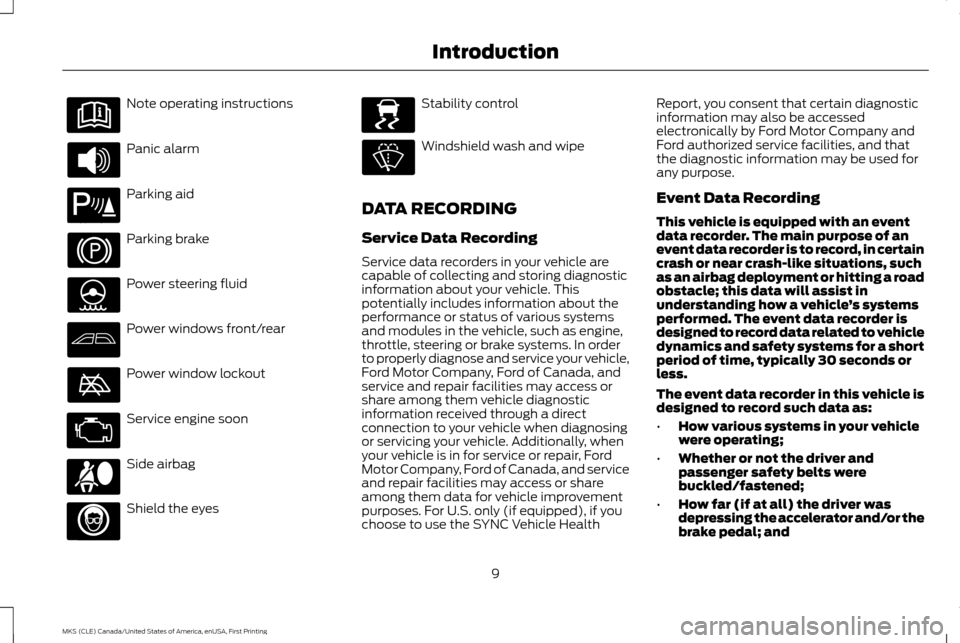
Note operating instructions
Panic alarm
Parking aid
Parking brake
Power steering fluid
Power windows front/rear
Power window lockout
Service engine soon
Side airbag
Shield the eyes Stability control
Windshield wash and wipe
DATA RECORDING
Service Data Recording
Service data recorders in your vehicle are
capable of collecting and storing diagnostic
information about your vehicle. This
potentially includes information about the
performance or status of various systems
and modules in the vehicle, such as engine,
throttle, steering or brake systems. In order
to properly diagnose and service your vehicle,
Ford Motor Company, Ford of Canada, and
service and repair facilities may access or
share among them vehicle diagnostic
information received through a direct
connection to your vehicle when diagnosing
or servicing your vehicle. Additionally, when
your vehicle is in for service or repair, Ford
Motor Company, Ford of Canada, and service
and repair facilities may access or share
among them data for vehicle improvement
purposes. For U.S. only (if equipped), if you
choose to use the SYNC Vehicle Health Report, you consent that certain diagnostic
information may also be accessed
electronically by Ford Motor Company and
Ford authorized service facilities, and that
the diagnostic information may be used for
any purpose.
Event Data Recording
This vehicle is equipped with an event
data recorder. The main purpose of an
event data recorder is to record, in certain
crash or near crash-like situations, such
as an airbag deployment or hitting a road
obstacle; this data will assist in
understanding how a vehicle
’s systems
performed. The event data recorder is
designed to record data related to vehicle
dynamics and safety systems for a short
period of time, typically 30 seconds or
less.
The event data recorder in this vehicle is
designed to record such data as:
• How various systems in your vehicle
were operating;
• Whether or not the driver and
passenger safety belts were
buckled/fastened;
• How far (if at all) the driver was
depressing the accelerator and/or the
brake pedal; and
9
MKS (CLE) Canada/United States of America, enUSA, First Printing Introduction E139213 E167012 E138639
Page 13 of 382
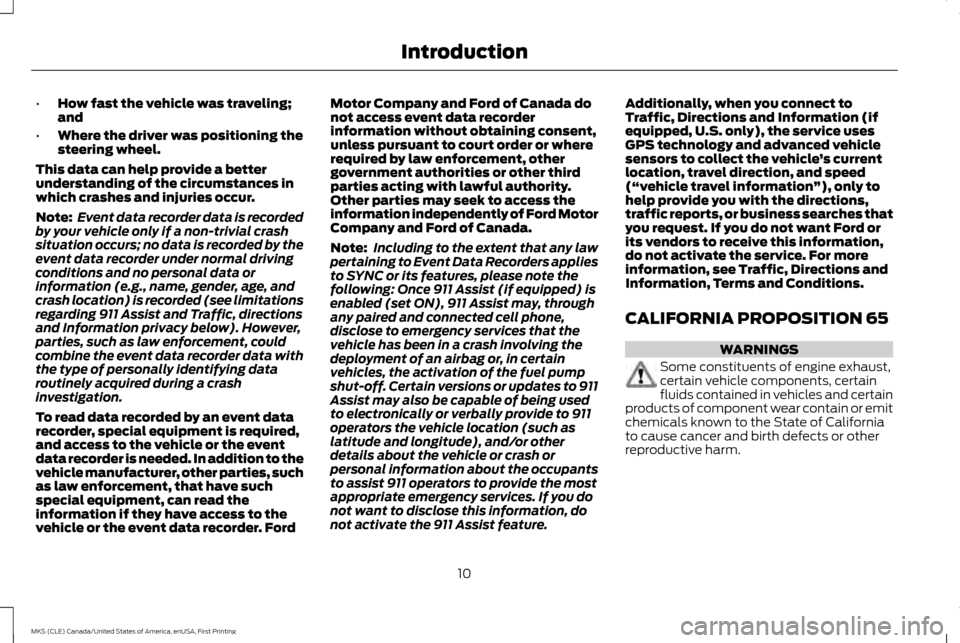
•
How fast the vehicle was traveling;
and
• Where the driver was positioning the
steering wheel.
This data can help provide a better
understanding of the circumstances in
which crashes and injuries occur.
Note: Event data recorder data is recorded
by your vehicle only if a non-trivial crash
situation occurs; no data is recorded by the
event data recorder under normal driving
conditions and no personal data or
information (e.g., name, gender, age, and
crash location) is recorded (see limitations
regarding 911 Assist and Traffic, directions
and Information privacy below). However,
parties, such as law enforcement, could
combine the event data recorder data with
the type of personally identifying data
routinely acquired during a crash
investigation.
To read data recorded by an event data
recorder, special equipment is required,
and access to the vehicle or the event
data recorder is needed. In addition to the
vehicle manufacturer, other parties, such
as law enforcement, that have such
special equipment, can read the
information if they have access to the
vehicle or the event data recorder. Ford Motor Company and Ford of Canada do
not access event data recorder
information without obtaining consent,
unless pursuant to court order or where
required by law enforcement, other
government authorities or other third
parties acting with lawful authority.
Other parties may seek to access the
information independently of Ford Motor
Company and Ford of Canada.
Note:
Including to the extent that any law
pertaining to Event Data Recorders applies
to SYNC or its features, please note the
following: Once 911 Assist (if equipped) is
enabled (set ON), 911 Assist may, through
any paired and connected cell phone,
disclose to emergency services that the
vehicle has been in a crash involving the
deployment of an airbag or, in certain
vehicles, the activation of the fuel pump
shut-off. Certain versions or updates to 911
Assist may also be capable of being used
to electronically or verbally provide to 911
operators the vehicle location (such as
latitude and longitude), and/or other
details about the vehicle or crash or
personal information about the occupants
to assist 911 operators to provide the most
appropriate emergency services. If you do
not want to disclose this information, do
not activate the 911 Assist feature. Additionally, when you connect to
Traffic, Directions and Information (if
equipped, U.S. only), the service uses
GPS technology and advanced vehicle
sensors to collect the vehicle
’s current
location, travel direction, and speed
(“ vehicle travel information ”), only to
help provide you with the directions,
traffic reports, or business searches that
you request. If you do not want Ford or
its vendors to receive this information,
do not activate the service. For more
information, see Traffic, Directions and
Information, Terms and Conditions.
CALIFORNIA PROPOSITION 65 WARNINGS
Some constituents of engine exhaust,
certain vehicle components, certain
fluids contained in vehicles and certain
products of component wear contain or emit
chemicals known to the State of California
to cause cancer and birth defects or other
reproductive harm.
10
MKS (CLE) Canada/United States of America, enUSA, First Printing Introduction
Page 14 of 382
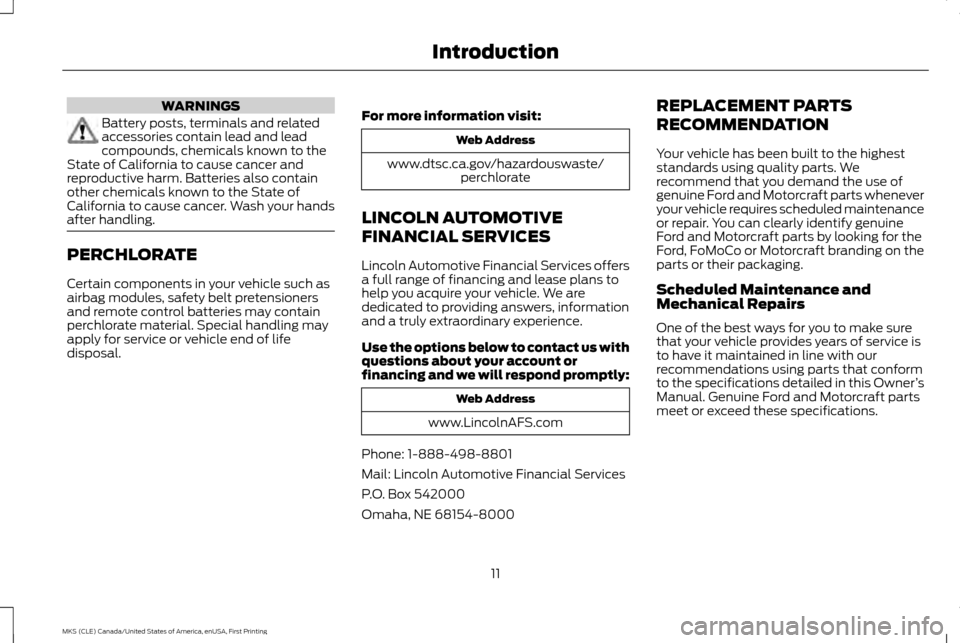
WARNINGS
Battery posts, terminals and related
accessories contain lead and lead
compounds, chemicals known to the
State of California to cause cancer and
reproductive harm. Batteries also contain
other chemicals known to the State of
California to cause cancer. Wash your hands
after handling. PERCHLORATE
Certain components in your vehicle such as
airbag modules, safety belt pretensioners
and remote control batteries may contain
perchlorate material. Special handling may
apply for service or vehicle end of life
disposal.
For more information visit: Web Address
www.dtsc.ca.gov/hazardouswaste/ perchlorate
LINCOLN AUTOMOTIVE
FINANCIAL SERVICES
Lincoln Automotive Financial Services offers
a full range of financing and lease plans to
help you acquire your vehicle. We are
dedicated to providing answers, information
and a truly extraordinary experience.
Use the options below to contact us with
questions about your account or
financing and we will respond promptly: Web Address
www.LincolnAFS.com
Phone: 1-888-498-8801
Mail: Lincoln Automotive Financial Services
P.O. Box 542000
Omaha, NE 68154-8000 REPLACEMENT PARTS
RECOMMENDATION
Your vehicle has been built to the highest
standards using quality parts. We
recommend that you demand the use of
genuine Ford and Motorcraft parts whenever
your vehicle requires scheduled maintenance
or repair. You can clearly identify genuine
Ford and Motorcraft parts by looking for the
Ford, FoMoCo or Motorcraft branding on the
parts or their packaging.
Scheduled Maintenance and
Mechanical Repairs
One of the best ways for you to make sure
that your vehicle provides years of service is
to have it maintained in line with our
recommendations using parts that conform
to the specifications detailed in this Owner
’s
Manual. Genuine Ford and Motorcraft parts
meet or exceed these specifications.
11
MKS (CLE) Canada/United States of America, enUSA, First Printing Introduction
Page 15 of 382
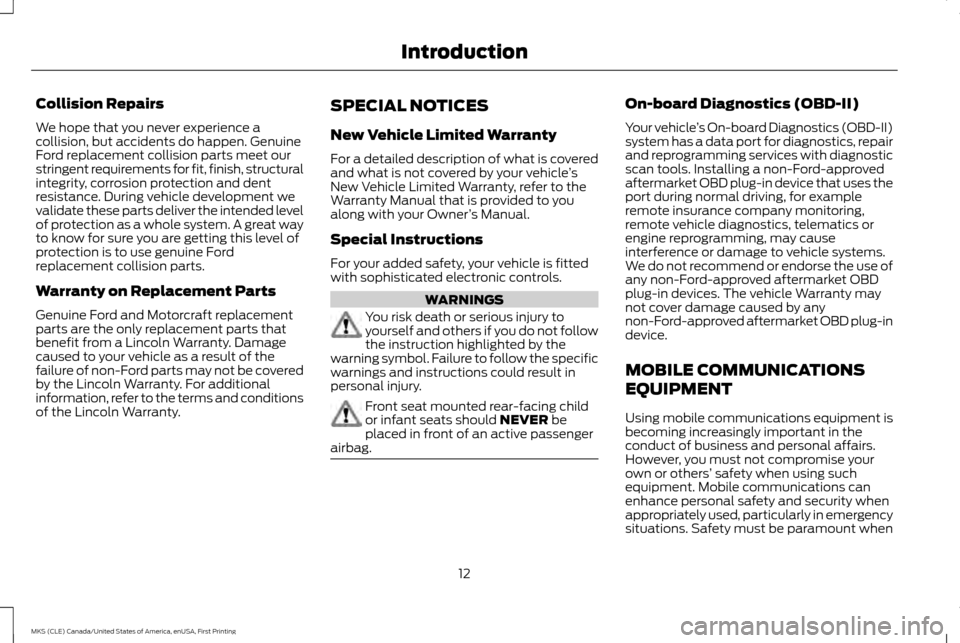
Collision Repairs
We hope that you never experience a
collision, but accidents do happen. Genuine
Ford replacement collision parts meet our
stringent requirements for fit, finish, structural
integrity, corrosion protection and dent
resistance. During vehicle development we
validate these parts deliver the intended level
of protection as a whole system. A great way
to know for sure you are getting this level of
protection is to use genuine Ford
replacement collision parts.
Warranty on Replacement Parts
Genuine Ford and Motorcraft replacement
parts are the only replacement parts that
benefit from a Lincoln Warranty. Damage
caused to your vehicle as a result of the
failure of non-Ford parts may not be covered
by the Lincoln Warranty. For additional
information, refer to the terms and conditions
of the Lincoln Warranty.
SPECIAL NOTICES
New Vehicle Limited Warranty
For a detailed description of what is covered
and what is not covered by your vehicle
’s
New Vehicle Limited Warranty, refer to the
Warranty Manual that is provided to you
along with your Owner ’s Manual.
Special Instructions
For your added safety, your vehicle is fitted
with sophisticated electronic controls. WARNINGS
You risk death or serious injury to
yourself and others if you do not follow
the instruction highlighted by the
warning symbol. Failure to follow the specific
warnings and instructions could result in
personal injury. Front seat mounted rear-facing child
or infant seats should NEVER be
placed in front of an active passenger
airbag. On-board Diagnostics (OBD-II)
Your vehicle
’s On-board Diagnostics (OBD-II)
system has a data port for diagnostics, repair
and reprogramming services with diagnostic
scan tools. Installing a non-Ford-approved
aftermarket OBD plug-in device that uses the
port during normal driving, for example
remote insurance company monitoring,
remote vehicle diagnostics, telematics or
engine reprogramming, may cause
interference or damage to vehicle systems.
We do not recommend or endorse the use of
any non-Ford-approved aftermarket OBD
plug-in devices. The vehicle Warranty may
not cover damage caused by any
non-Ford-approved aftermarket OBD plug-in
device.
MOBILE COMMUNICATIONS
EQUIPMENT
Using mobile communications equipment is
becoming increasingly important in the
conduct of business and personal affairs.
However, you must not compromise your
own or others’ safety when using such
equipment. Mobile communications can
enhance personal safety and security when
appropriately used, particularly in emergency
situations. Safety must be paramount when
12
MKS (CLE) Canada/United States of America, enUSA, First Printing Introduction
Page 16 of 382
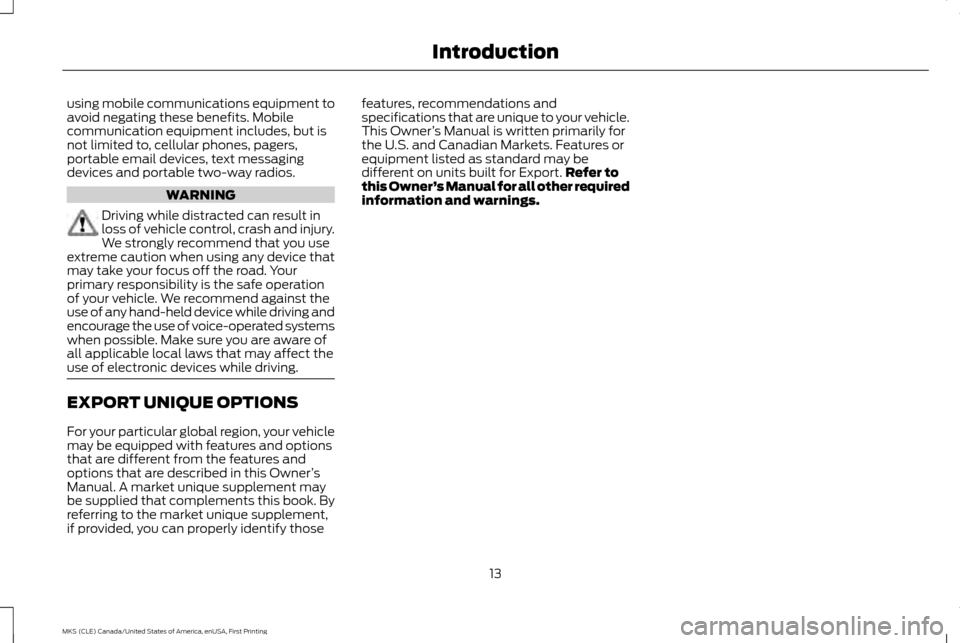
using mobile communications equipment to
avoid negating these benefits. Mobile
communication equipment includes, but is
not limited to, cellular phones, pagers,
portable email devices, text messaging
devices and portable two-way radios.
WARNING
Driving while distracted can result in
loss of vehicle control, crash and injury.
We strongly recommend that you use
extreme caution when using any device that
may take your focus off the road. Your
primary responsibility is the safe operation
of your vehicle. We recommend against the
use of any hand-held device while driving and
encourage the use of voice-operated systems
when possible. Make sure you are aware of
all applicable local laws that may affect the
use of electronic devices while driving. EXPORT UNIQUE OPTIONS
For your particular global region, your vehicle
may be equipped with features and options
that are different from the features and
options that are described in this Owner
’s
Manual. A market unique supplement may
be supplied that complements this book. By
referring to the market unique supplement,
if provided, you can properly identify those features, recommendations and
specifications that are unique to your vehicle.
This Owner
’s Manual is written primarily for
the U.S. and Canadian Markets. Features or
equipment listed as standard may be
different on units built for Export. Refer to
this Owner ’s Manual for all other required
information and warnings.
13
MKS (CLE) Canada/United States of America, enUSA, First Printing Introduction
Page 17 of 382
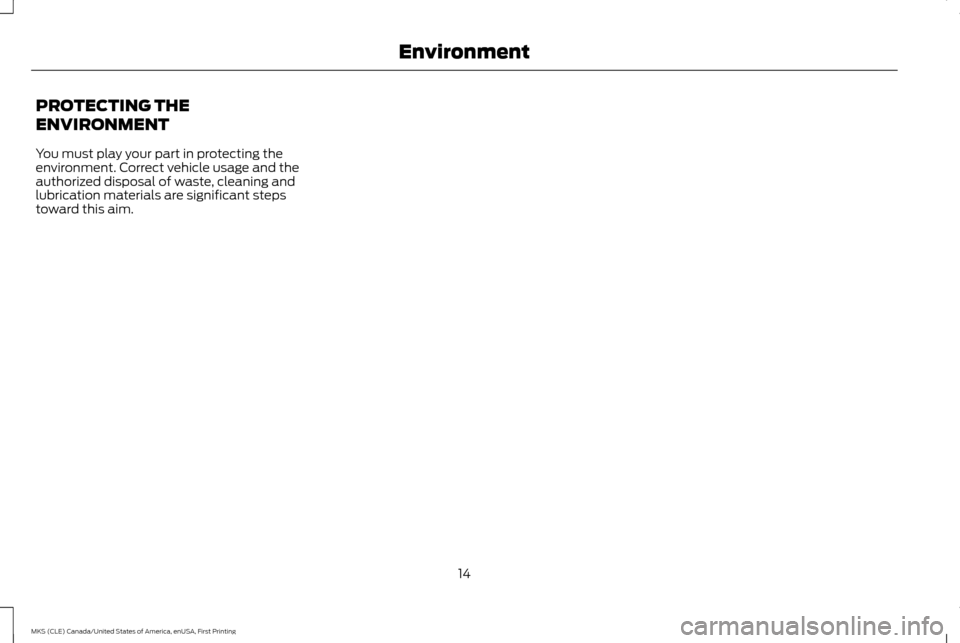
PROTECTING THE
ENVIRONMENT
You must play your part in protecting the
environment. Correct vehicle usage and the
authorized disposal of waste, cleaning and
lubrication materials are significant steps
toward this aim.
14
MKS (CLE) Canada/United States of America, enUSA, First Printing Environment
Page 18 of 382
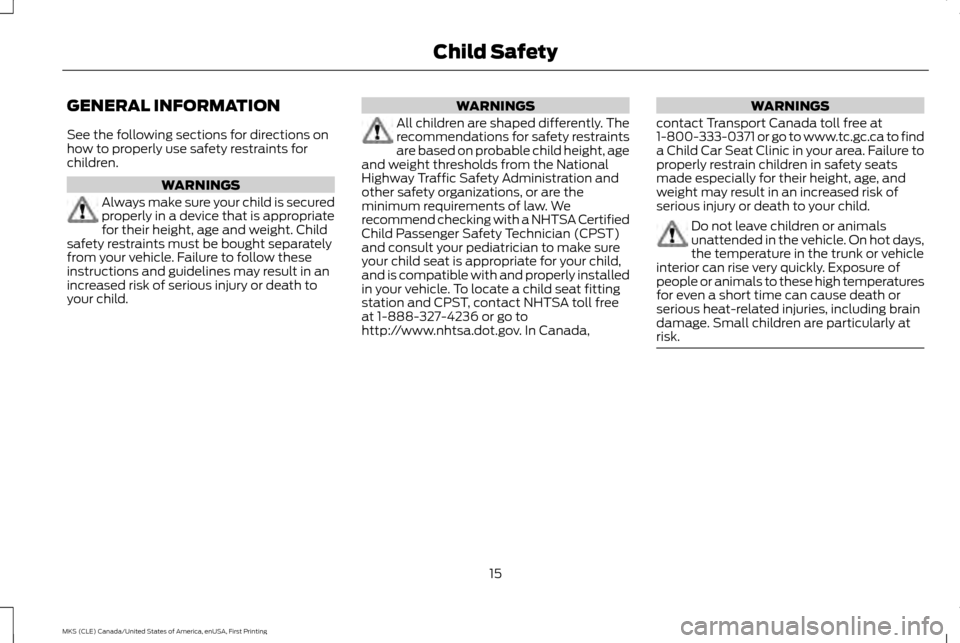
GENERAL INFORMATION
See the following sections for directions on
how to properly use safety restraints for
children.
WARNINGS
Always make sure your child is secured
properly in a device that is appropriate
for their height, age and weight. Child
safety restraints must be bought separately
from your vehicle. Failure to follow these
instructions and guidelines may result in an
increased risk of serious injury or death to
your child. WARNINGS
All children are shaped differently. The
recommendations for safety restraints
are based on probable child height, age
and weight thresholds from the National
Highway Traffic Safety Administration and
other safety organizations, or are the
minimum requirements of law. We
recommend checking with a NHTSA Certified
Child Passenger Safety Technician (CPST)
and consult your pediatrician to make sure
your child seat is appropriate for your child,
and is compatible with and properly installed
in your vehicle. To locate a child seat fitting
station and CPST, contact NHTSA toll free
at 1-888-327-4236 or go to
http://www.nhtsa.dot.gov. In Canada, WARNINGS
contact Transport Canada toll free at
1-800-333-0371 or go to www.tc.gc.ca to find
a Child Car Seat Clinic in your area. Failure to
properly restrain children in safety seats
made especially for their height, age, and
weight may result in an increased risk of
serious injury or death to your child. Do not leave children or animals
unattended in the vehicle. On hot days,
the temperature in the trunk or vehicle
interior can rise very quickly. Exposure of
people or animals to these high temperatures
for even a short time can cause death or
serious heat-related injuries, including brain
damage. Small children are particularly at
risk. 15
MKS (CLE) Canada/United States of America, enUSA, First Printing Child Safety
Page 19 of 382
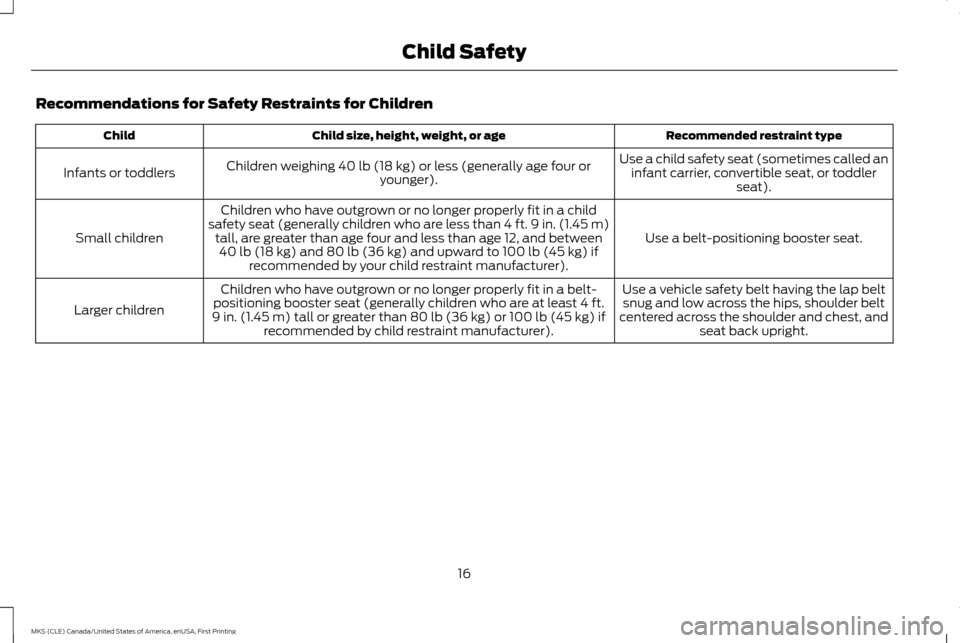
Recommendations for Safety Restraints for Children
Recommended restraint type
Child size, height, weight, or age
Child
Use a child safety seat (sometimes called aninfant carrier, convertible seat, or toddler seat).
Children weighing 40 lb (18 kg) or less (generally age four or
younger).
Infants or toddlers
Use a belt-positioning booster seat.
Children who have outgrown or no longer properly fit in a child
safety seat (generally children who are less than 4 ft. 9 in. (1.45 m) tall, are greater than age four and less than age 12, and between40 lb (18 kg) and 80 lb (36 kg) and upward to 100 lb (45 kg) if recommended by your child restraint manufacturer).
Small children
Use a vehicle safety belt having the lap beltsnug and low across the hips, shoulder belt
centered across the shoulder and chest, and seat back upright.
Children who have outgrown or no longer properly fit in a belt-
positioning booster seat (generally children who are at least 4 ft.
9 in. (1.45 m) tall or greater than 80 lb (36 kg) or 100 lb (45 kg) if recommended by child restraint manufacturer).
Larger children
16
MKS (CLE) Canada/United States of America, enUSA, First Printing Child Safety
Page 20 of 382
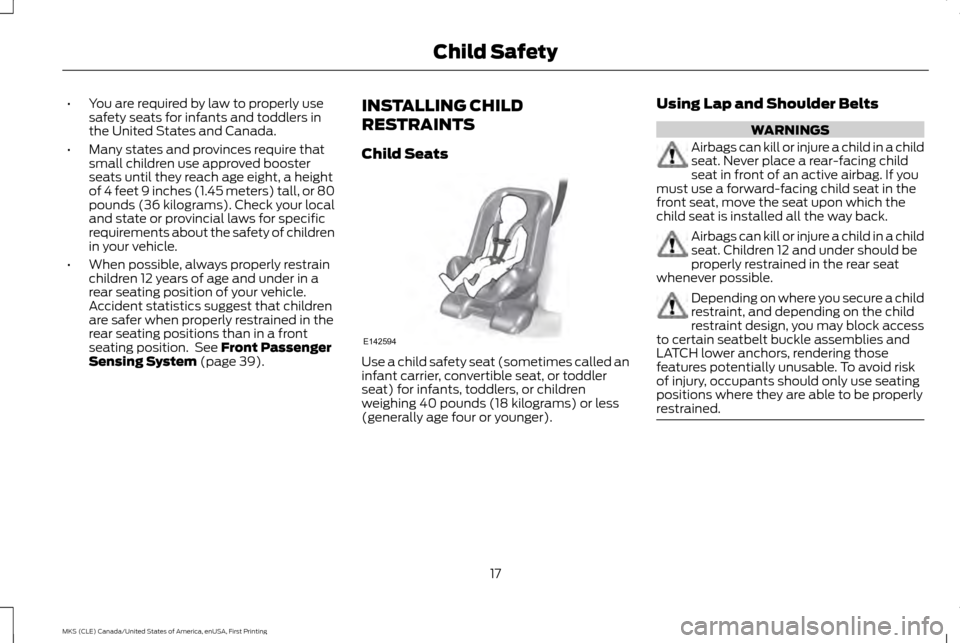
•
You are required by law to properly use
safety seats for infants and toddlers in
the United States and Canada.
• Many states and provinces require that
small children use approved booster
seats until they reach age eight, a height
of 4 feet 9 inches (1.45 meters) tall, or 80
pounds (36 kilograms). Check your local
and state or provincial laws for specific
requirements about the safety of children
in your vehicle.
• When possible, always properly restrain
children 12 years of age and under in a
rear seating position of your vehicle.
Accident statistics suggest that children
are safer when properly restrained in the
rear seating positions than in a front
seating position. See Front Passenger
Sensing System (page 39). INSTALLING CHILD
RESTRAINTS
Child Seats
Use a child safety seat (sometimes called an
infant carrier, convertible seat, or toddler
seat) for infants, toddlers, or children
weighing 40 pounds (18 kilograms) or less
(generally age four or younger).Using Lap and Shoulder Belts WARNINGS
Airbags can kill or injure a child in a child
seat. Never place a rear-facing child
seat in front of an active airbag. If you
must use a forward-facing child seat in the
front seat, move the seat upon which the
child seat is installed all the way back. Airbags can kill or injure a child in a child
seat. Children 12 and under should be
properly restrained in the rear seat
whenever possible. Depending on where you secure a child
restraint, and depending on the child
restraint design, you may block access
to certain seatbelt buckle assemblies and
LATCH lower anchors, rendering those
features potentially unusable. To avoid risk
of injury, occupants should only use seating
positions where they are able to be properly
restrained. 17
MKS (CLE) Canada/United States of America, enUSA, First Printing Child SafetyE142594